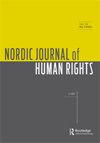为什么不同种族间的性暴力程度不同?孟加拉人和库尔德人种族灭绝的比较
IF 1.2
Q3 POLITICAL SCIENCE
引用次数: 0
摘要
是什么导致了种族灭绝中性暴力发生率的差异?我们研究了性暴力可能被用作种族灭绝战略的条件,以及国家和群体层面机构中的权力动态。为了探讨种族灭绝运动中性暴力的动态,我们对两个案例进行了比较研究:1971年的孟加拉种族灭绝,其中性暴力程度很高;1987-1989年的库尔德种族灭绝,其中性暴力程度较低。我们的发现可能有助于了解武装团体的行为和种族灭绝暴力的动态。我们发现微观动力学和个人行为比纯粹的结构方法更好地解释了种族灭绝暴力的曲目。在这两个案例中,似乎在群体领导人的控制和性暴力的流行之间存在因果关系。领导人- -特别是军事领导人- -的态度和行为可能极大地影响武装集团的暴力行为。如果他们选择这样做,指挥官就有能力建立防止强奸的制度。本文章由计算机程序翻译,如有差异,请以英文原文为准。
Why do the Levels of Sexual Violence Vary Across Genocides? A Comparison of the Bengali and Kurdish Genocides
ABSTRACT What causes variation in the prevalence of sexual violence across genocides? We examine the conditions under which sexual violence may be used as a strategy of genocide, and the power dynamics in institutions at the state- and group-level. In order to explore the dynamics of sexual violence in genocidal campaigns we conduct a comparative study with two cases: the Bengali genocide of 1971, in which there were high levels of sexual violence, and the Kurdish genocide of 1987–1989, in which the levels of sexual violence were low. Our findings may shed light on the behaviour of armed groups and the dynamics of genocidal violence. We find that micro-dynamics and individual behaviour better explain repertoires of genocidal violence than purely structural approaches. In the two cases, there seems to be a causal link between group leaders’ control and the prevalence of sexual violence. The attitude and behaviour of leaders – particularly military leaders – could immensely affect armed group’s repertoire of violence. If they choose to do so, commanders are capable of building institutions to prevent rape.
求助全文
通过发布文献求助,成功后即可免费获取论文全文。
去求助
来源期刊

Nordic Journal of Human Rights
POLITICAL SCIENCE-
CiteScore
1.00
自引率
25.00%
发文量
29
期刊介绍:
The Nordic Journal of Human Rights is the Nordic countries’ leading forum for analyses, debate and information about human rights. The Journal’s aim is to provide a cutting-edge forum for international academic critique and analysis in the field of human rights. The Journal takes a broad view of human rights, and wishes to publish high quality and cross-disciplinary analyses and comments on the past, current and future status of human rights for profound collective reflection. It was first issued in 1982 and is published by the Norwegian Centre for Human Rights at the University of Oslo in collaboration with Nordic research centres for human rights.
 求助内容:
求助内容: 应助结果提醒方式:
应助结果提醒方式:


